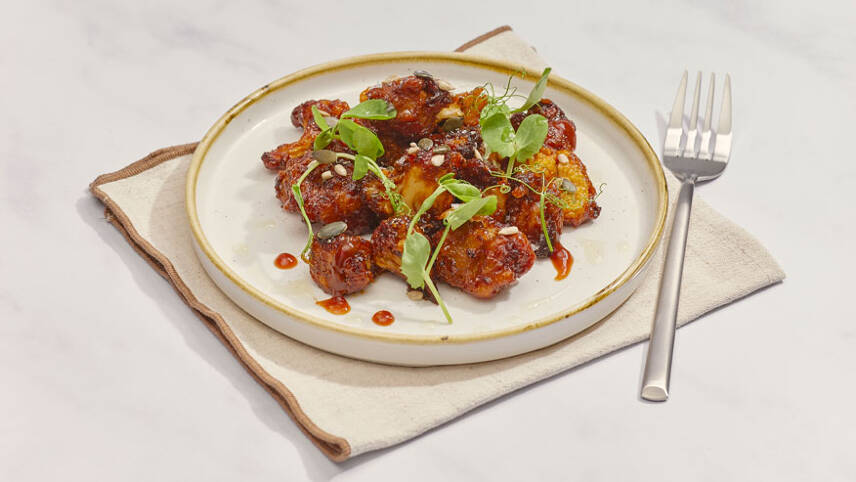Register for free and continue reading
Join our growing army of changemakers and get unlimited access to our premium content

Pictured: A new starter option, gochujang cauliflower wings. Image: Hilton
The hotel chain first introduced carbon labelling to its menus in May. The labels were provided at 30 hotels including locations in London, Leeds, Liverpool and Newcastle. Hilton claims this marked the start of the largest carbon labelling exercise by a hotel firm in Britain.
Hilton worked with Klimato to calculate the lifecycle carbon footprint of its menu items and communicate this data with diners. Klimato’s label consists of a circle that is filled with green to a level dependent on the emissions footprint of the dish. A full or almost-full circle indicates a high-carbon choice. A low-carbon choice is indicated with a mostly empty circle.
Any dish generating more than 1.6kg of CO2e across its lifecycle is regarded as a high-carbon choice. The labels tell diners that these dishes “contribute to increased climate impact”. All dishes are labelled with CO2e emissions in grams/kilograms.
This is notably the same carbon labelling system used at the UN climate summit in Glasgow in 2021, COP26.
Hilton has observed that the introduction of the labels has led to diners choosing more low-carbon and medium-carbon dishes.
The hotelier, therefore, worked with its menu development team to skew autumn menus away from high-carbon dishes. More than 85% of Hitlon’s autumn menus in the UK now consist of options ranked as low or medium using the Klimato methodology.
Hilton EMEA’s vice president for food and beverage strategy and development, Emma Banks, said: “Carbon labelling is an easy way to empower guests to make more informed choices, and we’re delighted to see they’re already embracing these insights – whether that’s by opting for an ultra-low emission dish or simply reducing the frequency with which they order dishes with a higher carbon footprint.”
Earlier this year, separately, fast-casual Mexican restaurant chain Wahaca removed steak dishes from its menu after completing a carbon labelling exercise. The dishes were proven to be the most carbon-intense items on the menu.
Carbon labelling is currently voluntary in the UK for food firms. However, Chris Skidmore MP’s Net-Zero Review recommends the introduction of standardised environmental labelling on as many product categories as possible by 2025, with food as a priority focus. Skidmore noted that agriculture’s share of UK emissions is set to grow to 30% by 2030 without intervention, including changes to our diets.
Ministers have not yet committed to acting on this recommendation. At the recent Conservative Party Conference, Prime Minister Rishi Sunak said his Government would not tell people what to eat. Environment Secretary Therese Coffey also threw her support behind British meat and disparaged alternative proteins.
Related article: Just Eat for business pilots carbon labelling in London


Please login or Register to leave a comment.